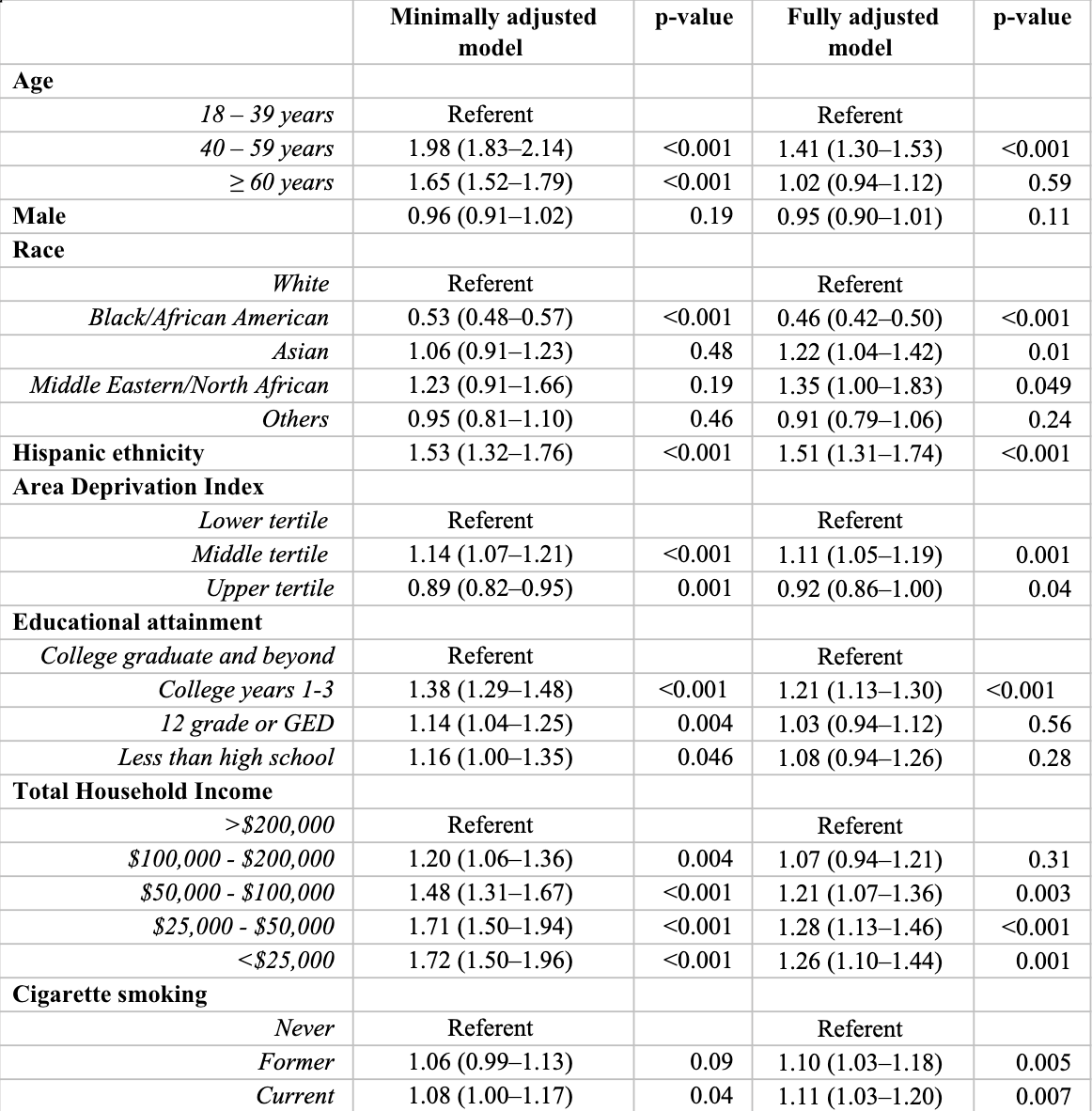Tuesday Poster Session
Category: Liver
P5888 - Predictors of Incident Metabolic Associated Steatohepatitis: The All of Us Research Program
Tuesday, October 28, 2025
10:30 AM - 4:00 PM PDT
Location: Exhibit Hall
- UA
Urwah Ahmad, MBBS (she/her/hers)
MedStar Georgetown University Hospital
Baltimore, MD
Presenting Author(s)
Urwah Ahmad, MBBS1, Yakubu Bene-Alhasan, MD2, Joseph Atarere, MD1, Mishal Ejaz, MBBS1, Boniface Mensah, MBChB, MPh1, Natalie A.Y.. Akoto, MBChB, MPH1, Priyanka Kanth, MD3
1MedStar Georgetown University Hospital, Baltimore, MD; 2Baylor College of Medicine, Baltimore, MD; 3MedStar Georgetown University Hospital, Washington, DC
Introduction: Metabolic-Associated Steatohepatitis (MASH) is a progressive, underdiagnosed liver disease linked to metabolic dysfunction. Despite its growing burden, prospective predictors remain poorly understood.
Methods: We analyzed data from 627,584 adults in the NIH All of Us Research Program (2018–present). After excluding those without EHR consent, with baseline MASH, or missing covariates, we evaluated associations between demographic, socioeconomic, and lifestyle factors and incident MASH. Our minimally adjusted model included age, sex, race, Hispanic ethnicity, household income, educational attainment, area deprivation index and smoking history. The fully adjusted model added cardio metabolic risk factors: hypertension, diabetes and body mass index.
Results: Our final sample included 203,910 adults. Over a mean follow-up of 42 ± 23 months, 5,107 developed MASH. After adjusting for covariates, risk was higher in individuals aged 40–59 vs. < 40 [adjusted Hazard Ratio (HR): 1.41, 95% CI: 1.30–1.53]; Asians [HR: 1.22, 1.04–1.42], Middle Eastern/North Africans [HR: 1.35, 1.00–1.83] vs. Whites, Hispanics [HR: 1.51, 1.31–1.74] vs. non-Hispanics; and among those with former HR [1.10, 1.03–1.18] and current cigarette use HR [1.11, 1.03–1.20], vs never use. Blacks had lower risk HR [0.46, 0.42–0.50] compared to Whites. Higher household income had an inverse dose-response association with incident MASH (2% lower risk per $10,000 higher income). No such associations were seen with educational attainment or area deprivation index.
Discussion: Demographic, socioeconomic, and lifestyle factors independently predict incident MASH. Targeted interventions should consider these risk profiles.

Figure: Hazard ratio of the association between viables and MASH
Disclosures:
Urwah Ahmad indicated no relevant financial relationships.
Yakubu Bene-Alhasan indicated no relevant financial relationships.
Joseph Atarere indicated no relevant financial relationships.
Mishal Ejaz indicated no relevant financial relationships.
Boniface Mensah indicated no relevant financial relationships.
Natalie Akoto indicated no relevant financial relationships.
Priyanka Kanth indicated no relevant financial relationships.
Urwah Ahmad, MBBS1, Yakubu Bene-Alhasan, MD2, Joseph Atarere, MD1, Mishal Ejaz, MBBS1, Boniface Mensah, MBChB, MPh1, Natalie A.Y.. Akoto, MBChB, MPH1, Priyanka Kanth, MD3. P5888 - Predictors of Incident Metabolic Associated Steatohepatitis: The All of Us Research Program, ACG 2025 Annual Scientific Meeting Abstracts. Phoenix, AZ: American College of Gastroenterology.
1MedStar Georgetown University Hospital, Baltimore, MD; 2Baylor College of Medicine, Baltimore, MD; 3MedStar Georgetown University Hospital, Washington, DC
Introduction: Metabolic-Associated Steatohepatitis (MASH) is a progressive, underdiagnosed liver disease linked to metabolic dysfunction. Despite its growing burden, prospective predictors remain poorly understood.
Methods: We analyzed data from 627,584 adults in the NIH All of Us Research Program (2018–present). After excluding those without EHR consent, with baseline MASH, or missing covariates, we evaluated associations between demographic, socioeconomic, and lifestyle factors and incident MASH. Our minimally adjusted model included age, sex, race, Hispanic ethnicity, household income, educational attainment, area deprivation index and smoking history. The fully adjusted model added cardio metabolic risk factors: hypertension, diabetes and body mass index.
Results: Our final sample included 203,910 adults. Over a mean follow-up of 42 ± 23 months, 5,107 developed MASH. After adjusting for covariates, risk was higher in individuals aged 40–59 vs. < 40 [adjusted Hazard Ratio (HR): 1.41, 95% CI: 1.30–1.53]; Asians [HR: 1.22, 1.04–1.42], Middle Eastern/North Africans [HR: 1.35, 1.00–1.83] vs. Whites, Hispanics [HR: 1.51, 1.31–1.74] vs. non-Hispanics; and among those with former HR [1.10, 1.03–1.18] and current cigarette use HR [1.11, 1.03–1.20], vs never use. Blacks had lower risk HR [0.46, 0.42–0.50] compared to Whites. Higher household income had an inverse dose-response association with incident MASH (2% lower risk per $10,000 higher income). No such associations were seen with educational attainment or area deprivation index.
Discussion: Demographic, socioeconomic, and lifestyle factors independently predict incident MASH. Targeted interventions should consider these risk profiles.

Figure: Hazard ratio of the association between viables and MASH
Disclosures:
Urwah Ahmad indicated no relevant financial relationships.
Yakubu Bene-Alhasan indicated no relevant financial relationships.
Joseph Atarere indicated no relevant financial relationships.
Mishal Ejaz indicated no relevant financial relationships.
Boniface Mensah indicated no relevant financial relationships.
Natalie Akoto indicated no relevant financial relationships.
Priyanka Kanth indicated no relevant financial relationships.
Urwah Ahmad, MBBS1, Yakubu Bene-Alhasan, MD2, Joseph Atarere, MD1, Mishal Ejaz, MBBS1, Boniface Mensah, MBChB, MPh1, Natalie A.Y.. Akoto, MBChB, MPH1, Priyanka Kanth, MD3. P5888 - Predictors of Incident Metabolic Associated Steatohepatitis: The All of Us Research Program, ACG 2025 Annual Scientific Meeting Abstracts. Phoenix, AZ: American College of Gastroenterology.
